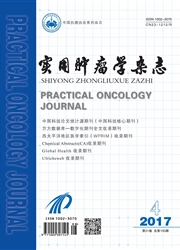

 中文摘要:
中文摘要:
目的研究使用抗血管生成药物联合放射治疗的荷瘤小鼠肿瘤组织中碳酸酐酶Ⅸ(CAIX)和乏氧诱导因子-1a(HIF-1a)mRNA的表达变化,并对组织基因表达变化的可能机制进行探讨。方法建立Lewis肺癌模型,将32只成瘤小鼠随机分为对照组(Control组)、恩度组(ES组)、放射治疗组(RT组)和恩度联合放疗组(ES+RT组),从治疗当天开始,隔日测量肿瘤体积,绘制肿瘤生长曲线。治疗结束后剥离瘤体,使用Real—timePCR方法对各处理组肿瘤组织中CAIX及HIF—lctmRNA的表达情况进行检测。结果从肿瘤生长曲线可以看出:ES+RT组与其余三组比较差异有统计学意义(P〈0.05),说明联合组抑瘤效果最好。以对照组为参照,ES组、RT组、ES+RT组CAIXmRNA的扩增倍数均下降,差异均有统计学意义(P〈0.05),ES+RT组下降最明显。以对照组为参照,ES组、RT组、ES+RT组的HIF—1a mRNA扩增倍数均下降,RT组、ES+RT组具有统计学意义(P〈0.05),ES组差异并无统计学意义(P〉0.05)。HIF-1a mRNA与CAIXmRNA表达呈正相关(r=0.68,P〈0.01)。结论恩度联合放疗显著抑制Lewis肺癌小鼠肿瘤的生长;同时能够改善肿瘤乏氧状况,抑制HIF-1a和CAIXmRNA的表达,可能是放疗增敏作用的机制之一。
 英文摘要:
英文摘要:
Objective To investigate CA IX and HIF - 1a mRNA expression changes in tumor - beating mice using anti - angiogenic drugs in conjunction with radiation therapy. To explore the possible mechanism of expression changes. Methods We established the model of Lewis lung carcinoma. 32 tumor bearing mices which were randomly divided into blank control group, the Endostar group, the radiotherapy group and ES + RT group, respectirely. From the day of treatment, tumors were measured every other day. Then, we would describe the tumor growth curve. After treatment,we would peel the tumor, using Real -time PCR method to detect the expression of CA IX and HIF - 1 a mRNA in the treated tumor tissues. Results From tumor growth curves, the difference was statistically significant, between ES + RT group and the remaining three groups (P 〈 0.05 ). As a reference to the blank group, CA IX mRNA amplification factor of the ES group, RT group and ES + RT group were decreased. ES + RT group of HIF - 1a mRNA amplification factor was decreased. HIF - 1 a mRNA and CA IX mRNA expres- sions were positively correlated ( r = 0.68, P 〈 0.01 ). Conclusion Endostar combined with radiotherapy significantly inhibit the growth of mice with Lewis lung tumor;improving the status of tumor hypoxia. Inhibition of HIF - 1 a and CA IX mRNA expression may be one of the mechanisms of radiation sensitizing effect.
 同期刊论文项目
同期刊论文项目
 同项目期刊论文
同项目期刊论文
 期刊信息
期刊信息
